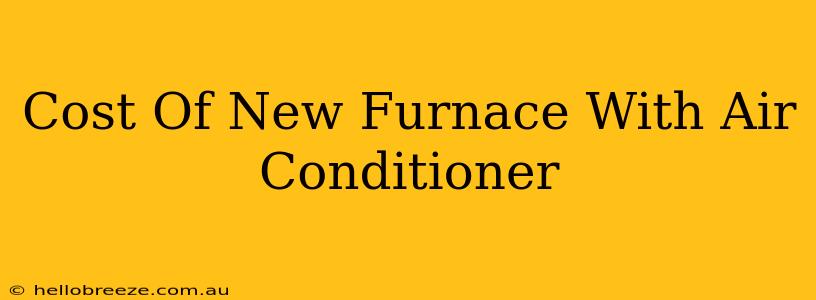Replacing your furnace and air conditioner can be a significant investment, but it's crucial for maintaining comfort and energy efficiency in your home. This guide breaks down the costs associated with purchasing and installing a new furnace and air conditioner, helping you budget effectively for this essential home upgrade.
Factors Affecting the Total Cost
Several factors influence the overall price of a new furnace and air conditioner installation. Understanding these will help you get accurate quotes from HVAC contractors.
1. System Size and Type:
- Size: The size of your system is determined by the square footage of your home and its insulation level. A larger home or one with poor insulation will require a more powerful, and therefore more expensive, system. Getting a properly sized system is vital for efficiency.
- Type: Furnace types include gas, electric, and oil, each with varying costs. Air conditioners are primarily heat pump or traditional AC units, with heat pumps often being more energy-efficient (and expensive upfront) but cheaper to run in the long term. Choosing the right type depends on your home's energy sources and climate.
2. SEER and AFUE Ratings:
- SEER (Seasonal Energy Efficiency Ratio): This rating measures the cooling efficiency of an air conditioner. Higher SEER ratings indicate greater efficiency and lower energy bills, but come with a higher upfront cost.
- AFUE (Annual Fuel Utilization Efficiency): This rating measures the heating efficiency of a furnace. Similar to SEER, higher AFUE ratings mean lower energy bills, although the initial investment will be higher. Look for high-efficiency units for long-term savings.
3. Installation Costs:
- Labor: Installation costs vary significantly based on your location, the complexity of the installation, and the contractor's rates. Factors like ductwork modifications or required permits add to the labor expense.
- Permits: Many areas require permits for HVAC installations. These permit fees are added to your overall cost.
4. Additional Features:
- Smart Thermostats: These programmable thermostats offer precise temperature control and energy savings. While they add to the upfront cost, the long-term savings can be substantial.
- Air Purifiers and Filters: Adding air purifiers or high-efficiency filters improves indoor air quality, benefiting allergy sufferers and enhancing overall health. This is an optional upgrade, but a worthwhile one.
- Zoned HVAC Systems: These systems allow for independent temperature control in different areas of the house, increasing comfort and energy efficiency. This is a more expensive option, but offers great flexibility.
Average Cost Ranges
While providing exact numbers is difficult due to varying factors, here are rough estimates for the cost of a new furnace and air conditioner:
- Basic System (low SEER/AFUE): $5,000 - $8,000 (This includes both the furnace and air conditioner)
- Mid-Range System (moderate SEER/AFUE): $8,000 - $12,000
- High-Efficiency System (high SEER/AFUE): $12,000 - $18,000+
Remember: These are just estimates. The actual cost will depend on the factors outlined above.
Getting Accurate Quotes
To get the most accurate cost estimate, contact several reputable HVAC contractors in your area. Be sure to:
- Provide detailed information: Give them the square footage of your home, the type of fuel you use, and any specific requirements you have.
- Compare quotes carefully: Don't just focus on the lowest price; consider the contractor's experience, reputation, and warranties offered.
- Ask about financing options: Many contractors offer financing plans to help make the purchase more manageable.
Replacing your furnace and air conditioner is a significant investment, but a well-chosen and properly installed system will provide years of comfortable and efficient climate control. By understanding the factors affecting the cost and getting multiple quotes, you can make an informed decision and budget effectively for this essential home upgrade.

